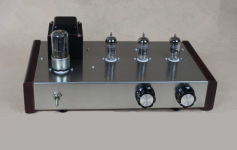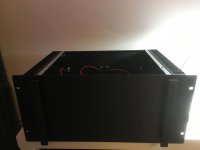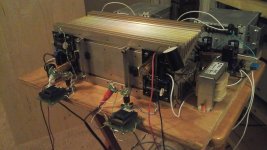DF=40.....goodWhat is the damping factor of mofo on 8ohm load?
It's not just about the swing, it's also about the gain, maybe more so. My findings are that you really want plenty of both for maximum enjoyment. E.g. >18dB. My ARC preamp does great with the MoFo's, so does the cheap little Chinese Marantz clone I'm listening to right now.
🙂
Michael - is it one of the many SC-7S2 clones on Ebay you are referring to?
Well, a classic newbie question.
Last night I did my first test to MOFO. At first, everything was fine, no smoke or strange sounds, but when I connected the interconnection cables there was a loud buzz. This only happened when connecting the source of sound (laptop, cell phone, cd player, on or off), and despite the noise they play music. Without interconnecting cables there are no noises of any kind in the speakers. Not even a buzz.
I did a point-to-point construction, following the Prassi layout in Post #82 (I'm sure it's fine, the problem is me). Where should I look for the problem?
I checked with the DMM any problems of poor insulation between the RCA inputs, circuit and transistors with chassis. No problems, but I noticed that checking the continuity between the positive and negative terminals of the speaker outputs gives me continuity (with the equipment turned off). Although it only happens if the choke is connected. Is it nomal in this design?. I check R5 (1K), and is ok.
I appreciate your guidance.
Last night I did my first test to MOFO. At first, everything was fine, no smoke or strange sounds, but when I connected the interconnection cables there was a loud buzz. This only happened when connecting the source of sound (laptop, cell phone, cd player, on or off), and despite the noise they play music. Without interconnecting cables there are no noises of any kind in the speakers. Not even a buzz.
I did a point-to-point construction, following the Prassi layout in Post #82 (I'm sure it's fine, the problem is me). Where should I look for the problem?
I checked with the DMM any problems of poor insulation between the RCA inputs, circuit and transistors with chassis. No problems, but I noticed that checking the continuity between the positive and negative terminals of the speaker outputs gives me continuity (with the equipment turned off). Although it only happens if the choke is connected. Is it nomal in this design?. I check R5 (1K), and is ok.
I appreciate your guidance.
Hi. Sorry for delay. Was at work. Is to late in night now. Only tomorrow will test one channel only, like you said. Thanks a lot Dennis!.
Well, a classic newbie question.
... (edited for length)
I checked with the DMM any problems of poor insulation between the RCA inputs, circuit and transistors with chassis. No problems, but I noticed that checking the continuity between the positive and negative terminals of the speaker outputs gives me continuity (with the equipment turned off). Although it only happens if the choke is connected. Is it nomal in this design?. I check R5 (1K), and is ok.
I appreciate your guidance.
The inductor is a dead short (minus a small winding resistance) to DC.
The Capacitor is a polar electrolytic that may pass DC in the reverse direction. Swap the leads on the ohm meter and see if it still registers continuity.
Also, check for DC on the output. C2 should block that if its polarity is correct and its not damaged.
HTH
really beautiful realization.Hello fellows, here is my MoFo. 5U chassis, Voltage 23, Bias 2A and Atoll preamp. This is very good sounding amp.
your power supply does not appear regulated. have you even tried a smps?
The inductor is a dead short (minus a small winding resistance) to DC.
The Capacitor is a polar electrolytic that may pass DC in the reverse direction. Swap the leads on the ohm meter and see if it still registers continuity.
Also, check for DC on the output. C2 should block that if its polarity is correct and its not damaged.
HTH
I solved the problem They were the electrolytic capacitors. In both channels they were bad. It works well and sounds splendid, despite using it with a laptop for now.
I'm negotiating a Yamaha C2 preamp, which has 18V output for use with MOFO. I think it will be enough for me, since I have very efficient speakers (+ 94db). Next, is make a DIY preamp for him.
Thank you all so much for your help.
I dabbled around with some single-ended power follower ideas but never built them. Then Michael came to the rescue with an article, a circuit and a PCB. I'm still experimenting so it's mounted on plywood right now.
Right now what's sounding nice is a P-channel version of Papa's B1 buffer into an auto-former for voltage gain (same heart of Papa's M2), driving MR's MoFo with IRFP140N.
The idea was a SE version (sort of) of the M2. About half the power, but a little more low level detail. Almost there....
Almost there....
Thanks Michael, really enjoy reading your articles.
Right now what's sounding nice is a P-channel version of Papa's B1 buffer into an auto-former for voltage gain (same heart of Papa's M2), driving MR's MoFo with IRFP140N.
The idea was a SE version (sort of) of the M2. About half the power, but a little more low level detail.
 Almost there....
Almost there....Thanks Michael, really enjoy reading your articles.
Attachments
Hello fellows, here is my MoFo. 5U chassis, Voltage 23, Bias 2A and Atoll preamp. This is very good sounding amp.
Super nice! 🙂
I dabbled around with some single-ended power follower ideas but never built them. Then Michael came to the rescue with an article, a circuit and a PCB. I'm still experimenting so it's mounted on plywood right now.
Right now what's sounding nice is a P-channel version of Papa's B1 buffer into an auto-former for voltage gain (same heart of Papa's M2), driving MR's MoFo with IRFP140N.
The idea was a SE version (sort of) of the M2. About half the power, but a little more low level detail.Almost there....
Thanks Michael, really enjoy reading your articles.
Looking good! Plywood makes it sound better. 😉 🙂
- Home
- Amplifiers
- Pass Labs
- Build This MoFo!




